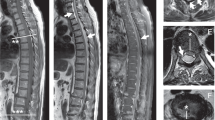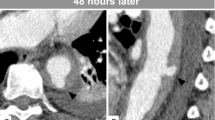Abstract
Study design: A case report of acute post-traumatic spinal subdural haematoma (ASSH).
Objective: To report a rare post-traumatic problem.
Setting: Dicle University Hospital, Diyarbakir, Turkey.
Method: A 3-year-old boy was admitted to our clinic with paraplegia 24 h after falling from a height of about 5 meters. Investigation revealed an acute spinal subdural haematoma.
Results: Following surgery there was marked improvement. The rehabilitation of the patient continues.
Conclusion: MRI is the most valuable diagnostic method. In each case diagnosed as ASSH, prompt evacuation should be performed before irreversible neurological damage occurs.
Similar content being viewed by others
Introduction
Spinal subdural haematoma is a rare condition associated with a variety of predisposing factors including haemorrhagic disorder, anticoagulant therapy, lumbar puncture, tumor, vascular malformation and trauma.1,2 Spinal subdural haematomas often develop acutely. It is generally agreed that prompt evacuation should be performed before irreversible damage to the spinal cord occurs.1,2,3
MRI may be indicated when an ASSH is suspected clinically. Generally, it is considered that urgent surgery is necessary.
Case Report
On November 20th, 2000 a 3-year-old boy was brought to a peripheral hospital. He was placed under observation with the preliminary diagnosis of cerebral contusion with brief loss of consciousness, vomiting and dorsal pain as a result of a fall from the balcony of his home (a fall of about 5 meters). He was referred to the University Hospital when he developed paraplegia.
Physical examination revealed confused consciousness, neck rigidity, irritability, urinary retention and lower extremity paraplegia. On admission to the University Hospital, Glasgow Coma Scale was 13 and ASIA score was A. The cranial computed tomography showed a minimal cerebral contusion in the right frontal region. The blood biochemistry and coagulation tests were normal. There was no bony pathology of the spine in the X-ray pictures. A diffuse acute spinal subdural haematoma (ASSH) was found in the MRI examination performed after 26 h trauma (Figures 1 and 2). He was immediately admitted to surgery 1 h after the MRI investigation. During the operation, a thoracic 6,7,8, laminectomy was performed and the epidural space appeared normal. The dura mater was bluish in color and tended to bulge. Opening of the dura revealed a partially organized haematoma. This was completely removed by aspiration and irrigation from the lower and upper levels of the laminectomy area via a soft and fine catheter. After evacuation of the haematoma, the spinal cord appeared normal. No other pathological appearance was noted. Histopathological examination of surgical material showed haemorrhagic material mixed with fibrin and histiocyts.
High dose methylprednisolone was administered post operatively. The paraplegia improved to a severe paraparasia after 48 h post operatively. He presented with a sensory level at Th 6 on the 3rd post operative day. He was discharged 20 days after a control MR image which demonstrated the sequel of laminectomy and complete decompression of the spinal cord (Figure 3).
The patient's paraparesis slowly improved. His leg function gradually improved and he was able to stand with a walker 3 months post operatively. Six months post operatively the patient was in good health, and his motor and sensory deficits had regressed. On discharge his ASIA score was D. The patient's rehabilitation continues at the present time.
Discussion
Acute spinal subdural haematoma occurs rarely. However, when it does occur, it may have disastrous consequences.1,4,5 It is usually associated with an underlying haematological disorder or other predisposing conditions.1,2 Trauma is considered a less common cause of ASSH.1,5 The development of a subdural haematoma is rare even after severe spinal injury.
Unlike epidural haematoma of the spinal cord, of which there are many reports in the literature, intraspinal subdural haematoma is uncommon. The anatomical reasons for such a disparity in numbers are probably related to the relatively larger and more vascular epidural fatty tissue.5,6 There was no gender predominance and only a slightly higher incidence among those aged in their fifties and sixties.4 However, there is no limit of age, and a 4-month-old patient and another of 80 years of age have been reported.2,7 Most are observed at the lumbar and thoracic levels.2,4,7 In our case, a 3-year-old boy, we found that the thoracolumbar and lumbar spine segment were widely involved (Figures 1 and 2). MRI has been advocated as an imaging study well suited for the detection of spinal haematomas.3
A laminectomy at several levels, the removal of the blood and an enlarging dura patch ensured the spinal decompression necessary for restoring neural function. This report is in good agreement with that of Gabl et al.8
The present case emphasises that in posttraumatic ASSH early surgical treatment is always indicated when the patient's neurological status progressively deteriorates.
References
Lee JI . Traumatic spinal subdural haematoma: rapid resolution after repeated lumbar spinal puncture and drainage J Trauma 1996 40: 654–655
Russell NA . Spinal subdural haematoma: a review Surg Neurol 1983 20: 133–137
Post MJD . Acute spinal subdural haematoma MR and CT finding with pathologic correlates AJNR 1994 15: 1895–1905
Domenicucci M . Nontraumatic acute spinal subdural haematoma: report of five cases and review of the literature J Neurosurg 1999 90: 255–257
Jovonen T . Widespread posttraumatic subdural haematoma-findings with spontaneous resolution J Trauma 1993 36: 262–264
Swann KW . Spontaneous spinal subarachnoid hemorrhage and subdural haematoma J Neurosurg 1984 61: 975–980
Jacquet G . Spinal subdural haematoma Zentralbl Neurochir 1991 52: 131–135
Gabl M . Acute spinal subdural haematoma Neurochirurgie 1988 31: 99–100
Author information
Authors and Affiliations
Rights and permissions
About this article
Cite this article
Özkan, Ü., Kemaloğlu, M., Aydin, M. et al. Widespread post-traumatic acute spinal subdural haematoma: case report and review of the literature. Spinal Cord 40, 304–306 (2002). https://doi.org/10.1038/sj.sc.3101258
Published:
Issue Date:
DOI: https://doi.org/10.1038/sj.sc.3101258






